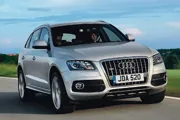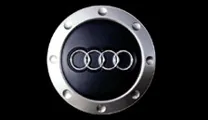Review
Another week, another new Audi. There seems to be no let up in the product onslaught from the German manufacturer.
In the same week as we were testing the new Q5, Audi announced details of the smaller Q3 which will arrive next year.
This hectic pace of product debuts means Audi will soon have nearly 40 models to offer – ideal for going into a fleet and offering a single-badge solution.
So where does the Q5 fit into this? User-choosers will be the key focus for Audi’s fleet sales team, appealing to those drivers who covet the brand and the lifestyle pretentions of an SUV.
And it’s fair to say that the Q5 will be an easier sell for Audi than its gargantuan Q7 sister car. While the Q5 is still unmistakably an SUV, it has a far more subtle road presence than the Q7.
The boot is also roomy, and the low loading sill means easy access with heavy loads.
Up front, the cabin architecture is pure Audi, and will be familiar to anyone who has driven an A4 or A5 lately.
The centre console and fascia is dominated by a large colour screen, and the associated controls for the MMI system are dotted logically around the gearbox.
The general fit and finish is top class, as it is with all Audis – it feels solid and you just know it will feel as solid and rattle-free in three years’ time.
The equipment list is also impressive – leather seats, steering wheel-mounted audio controls, CD player, climate control and rear parking sensors are standard, while outside are a set of 18-inch alloy wheels which fill out the wheelarches well.
On the road the Q5 strikes a good balance between handling and the lofty driving position which is demanded by SUV buyers.
During cornering there is barely any body roll, while ride comfort is excellent, with the Q5 soaking up road imperfections with ease.
The general feeling is that you are behind the wheel of a hatchback, rather than an SUV with its higher centre of gravity.
Under the bonnet is a 170bhp version of Audi’s new 2.0-litre common rail diesel engine, allied to a six-speed manual gearbox and Quattro four-wheel drive.
It makes for an impressive combination, with the diesel offering ample pulling power from low down in the rev range, and the gearbox shifting cleanly between ratios.
The engine is also very refined, with little noise at start-up and a subdued accompaniment when on the move. Wind and tyre noise are also well suppressed.
Strengths
- Stylish looks
- Build quality
- RV forecast
- Driveability
Weaknesses
- Front-end price
P11D Price
The Land Rover undercuts the rest and now comes with fuel-saving stop-start technology. All four offer similar equipment and power levels, but the Audi and BMW’s premium badge positioning means higher front-end costs. The Volvo sits well in between top and bottom.
Emissions and tax rates
The Land Rover’s front-end price advantage means it offers drivers the lowest benefit-in-kind bills – £210 a month for a 40% taxpayer. The BMW is next at £245 a month, closely followed by the Audi on £252. The Volvo’s high emissions mean a £264 a month BIK bill.
SMR cost
The Volvo runs on 17-inch alloy wheels and offers 18,000-mile service intervals which add up to the lowest service, maintenance and repair bills over three years/60,000 miles. The Audi offers variable servicing intervals but comes with larger, and more expensive, 18-inch alloys as standard.
Fuel cost
The BMW returns a claimed 43.5mpg on the combined cycle, putting it ahead here. The Land Rover with its stop-start system now delivers 42.2mpg (up from 37.7), while the Audi delivers 42.1mpg. The Volvo is off the pace with an average of 37.7mpg.
Depreciation cost
The Audi will be worth £12,825 (44% of cost new) after three years/ 60,000 miles, according to CAP. The Volvo will be worth £10,975 (41%) but its front-end price means less cash lost. The Land Rover will be worth £8,175 (34%) and the BMW £10,425 (35%).
Wholelife cost
The Volvo’s high fuel bill is offset by its class-leading depreciation and SMR performances. It will cost a fleet just under £25,000 over three years and 60,000 miles. The Audi is a close second, costing £54 more over the same period. The BMW is £3,000 adrift of the leader here.
Verdict
The BMW is way off the pace – it is five pence per mile more expensive to run over three years and 60,000 miles than the Volvo so it is the first to be discounted. The Land Rover puts in a much stronger showing now that it is available with the fuel saving stop-start system, resulting in the lowest monthly BIK bills for drivers.
However, in a market sector where image is key, the Freelander is not as new as the Audi or Volvo. Both come highly recommended, but for now the lower emissions and higher fuel economy of the Audi swing the balance in its favour. However, Volvo’s forthcoming front-wheel drive, sub-160g/km XC60 will change matters considerably.
Winner: Audi Q5 2.0 TDI Quattro SE



















